Beer glassware

Beer glassware comprises the drinking vessels made of glass designed or commonly used for drinking beer. Different styles of glassware exist for a number of reasons: they may reflect national traditions; legislation regarding serving measures; practicalities of stacking, washing and avoiding breakage; promotion of commercial breweries; folk art, novelty items or use in drinking games; or complementing different styles of beer for a variety of reasons, including enhancing aromatic volatiles, showcasing the appearance, and having an effect on the beer head. Several kinds of beer glassware have a stem which serves to prevent the body heat of the drinker's hand from warming the beer.
Beer glasses are made from a variety of materials not limited to glass, including stoneware, earthenware, pewter, and wood.
International styles
Pilsner glass
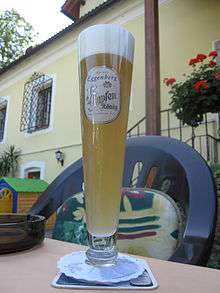
A pilsner glass is used for many types of light beers, including pale lager or pilsner. Pilsner glasses are generally smaller than a pint glass, usually in 200 ml, 250 ml, 300 ml, 330 ml or 400 ml sizes. (In Europe 500ml ones are common.) They are tall, slender and tapered. The slender glass reveals the colour, and carbonation of the beer,[1] and the broad top helps maintain a beer head.[2]
Weizen glasses are sometimes mistakenly called Pilsner glasses because they are somewhat similar in appearance, but true Pilsner glasses have an even taper without any amount of curvature.[3]
Pint glass
The definition of a pint differs by country, thus a pint glass will reflect the regular measure of beer in that country. In the UK, law stipulates that a servings of beer be fixed at the imperial pint (568 ml ≈1.2 US pints). Half-pint glasses of 10 imp fl oz (284 ml) are generally smaller versions of pint glasses. Quarter-pint glasses of 5 imp fl oz (142 ml) also exist, and are popular in Australia (now 140 ml from metrication), where they are known as a "pony". These may simply be smaller pint glasses, or may be a special pony glass. In the US, a pint is 16 US fl oz (473 ml), but the volume is not strictly regulated and glasses may vary somewhat. Glasses of 500ml are usually called pints in American parlance.
The common shapes of pint glass are:
- Conical glasses are shaped, as the name suggests, as an inverted truncated cone around 6 inches (15 cm) tall and tapering by about 1 inch (25 mm) in diameter over its height.
- The nonic, a variation on the conical design, where the glass bulges out a couple of inches from the top; this is partly for improved grip, partly to prevent the glasses from sticking together when stacked, and partly to give strength and stop the rim from becoming chipped or "nicked".[4] The term "nonic" derives from "no nick".
- Jug glasses, or "dimple mugs", are shaped more like a large mug with a handle. They are moulded with a grid pattern of thickened glass on the outside, somewhat resembling the segmentation of a WWII-era hand grenade. The dimples prevent the glass slipping out of the fingers in a washing-up bowl, and the design of the glass emphasises strength, also to withstand frequent manual washing. These design features became less important when manual washing was superseded by machine washing from the 1960s onwards. Dimpled glasses are now rarer than the other types and are regarded as more traditional.[5] This sort of glass is also known as a "Handle" due to the handle on the glass. They are popular with the older generation and people with restricted movement in their hands which can make holding a usual pint glass difficult. They have recently started to make a renaissance, especially in northern Britain.[6]
-

British dimpled glass pint mug
-
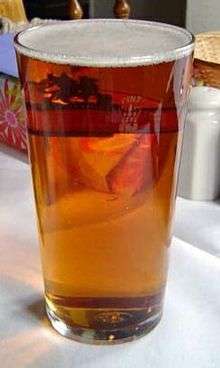
"Conical" pint glass
-
.svg.png)
"Nonic" pint glass.
-

Current Guinness glass
Connoisseur's glassware
Beer connoisseurs sometimes invest in special, non-traditional glassware to enhance their appreciation. An example was the range marketed by Michael "Beer Hunter" Jackson.
Snifters
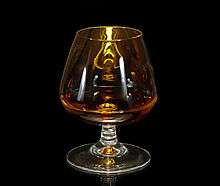
Typically used for serving brandy and cognac, a snifter is ideal for capturing the volatiles of aromatic beers such as, Double/Imperial IPAs, Belgian ales, barleywines and wheat wines. The shape helps trap the volatiles, while allowing swirling to agitate them and produce an intense aroma.
Taster glasses
Glasses holding 1/3 of a pint or less may be used to:
- Try a beer in a pub or cafe before purchasing a full measure
- Split a bottle of rare or strong beer between friends
- Sample multiple beers without becoming inebriated. For instance a brewpub might provide a sampler of three different brews in 1/3 pint measures; or a beer festival might provide small capacity glasses for patrons.
Plastic
Plastic beer vessels are usually shaped in imitation of whichever glasses are usual in the locality. They are mainly used as a substitute for glass vessels where breakages would be particularly problematic, for instance at outdoor events.
German, Austrian and Swiss styles
Weizen glasses

A weizen glass is used to serve wheat beer.[7] Originating in Germany the glass is narrow at the bottom and slightly wider at the top; the width both releasing aroma, and providing room for the often thick, fluffy heads produced by wheat beer.[8] It tends to be taller than a pint glass, and generally holds 500 millilitres with room for foam or "head". In some countries, such as Belgium, the glass may be 250 ml or 330 ml.
Wheat beers tend to foam a lot, especially if poured quickly. In pubs, if the bottle is handed to the patron for self pouring, it is customary for the glass to be taken to the patron wet or with a bit of water in the bottom to be swirled around to wet the entire glass to keep the beer from foaming excessively.
Beer stein
A Beer stein or simply stein /ˈstaɪn/[9] is an English neologism for either traditional beer mugs made out of stoneware, or specifically ornamental beer mugs that are usually sold as souvenirs or collectibles. Such Steins may be made out of stoneware (rarely the inferior earthenware), pewter, porcelain, or even silver, wood or crystal glass; they may have open tops or hinged pewter lids with a thumb-lever. Steins usually come in sizes of a half litre or a full litre (or comparable historic sizes). Like decorative tankards, they are often decorated in a nostalgic manner, but with allusions to Germany or Bavaria. It is believed by some that the lid was implemented during the age of the Black Plague, to prevent diseased flies from getting into the beer.[10]
Maß
The Maß (pronounced [ˈmas] and the Bavarian word of female grammatical gender, thus die Maß, for a mug containing one litre of liquid, though commonly misinterpreted as the Standard German noun Maß, pronounced [ˈmaːs] and grammatically neuter, thus das Maß, and translating to "measure") is a term used in German-speaking countries for a unit of volume, now typically used only for measuring beer sold for immediate on-site consumption. In modern times, a Maß is defined as exactly 1 litre. As a maß is a unit of measure, various designs are possible: modern maß krugs are often handled glass tankards, although they may also be in the form of steins.
Stangen
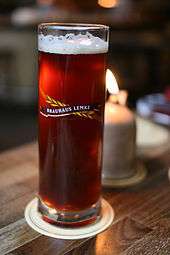
The high, narrow and cylindrical stange (German: stick or rod) is traditionally used for Kölsch. A becher, traditionally used for altbier, is similar, though slightly shorter and fatter. The stange usually holds between 100 ml and 200 ml (though larger ones are now sometimes used to reduce serving work). Stangen are carried by slotting them into holes in a special tray called a Kranz ("wreath")
Willi Becher
.jpg)
Willi Becher, Willy mugs, that is synonymous with the German standard glass. It is characterized by its shape: conical to the top portion where it curves inward to converge back to the top of a smaller diameter opening. The Willi cup is produced in sizes of 0.2 l , 0.25 l , 0.3 l , 0.4 l and 0.5 l.
Its name comes from its inventor Willy Steinmeier, then head of sales at Glassworks Ruhrglas AG. He has helped the Willi Becher to its unobtrusive design. The glass has been produced since 1954 and the company sells over ten million units per year.
Beer Boot
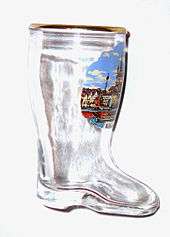
Beer boots (or Bierstiefel) have over a century of history and culture behind them. It is commonly believed that a general somewhere promised his troops to drink beer from his boot if they were successful in battle. When the troops prevailed, the general had a glassmaker fashion a boot from glass to fulfill his promise without tasting his own feet and to avoid spoiling the beer in his leather boot. Since then, soldiers have enjoyed toasting to their victories with a beer boot. At gatherings in Germany, Austria and Switzerland, beer boots are often passed among the guests for a festive drinking challenge. Since the movie Beerfest appeared in 2006, beer boots have become increasingly popular in the United States.[11]
It is an old joke to hand the boot to a young novice drinker with the tip pointing away from his person, which will result in beer pouring over the drinker's face uncontrollably when air enters the tip; seasoned drinkers always point the tip towards their body until the glass is sufficiently drained. Beer boots are made of either manufactured pressed glass or mouth blown glasses by skilled artisans in form of a boot.
Pilstulpe
.jpg)
The Pilstulpe ("Pilsner Tulip") or Biertulpe ("Beer tulip") is the tradition glass for German pilsner beers. Sizes are typically around 300 millilitres (11 imp fl oz; 10 US fl oz), but can be as large as 500 millilitres (18 imp fl oz; 17 US fl oz). When used in restaurant settings, a small piece of absorbent paper is placed around the base to absorb any drips from spilling or condensation.
Gallery
-
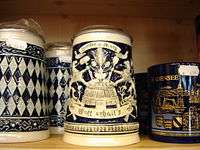
Elaborate earthenware beer steins
-

Common half-litre Humpen or beer mug.
-

Warsteiner glass
-

A Maßkrug of Augustiner Bräu.
Belgian and Dutch styles
Stronger or bottled beers are often served in specially made, elaborately branded glassware.
Flute glass
A vessel similar to a champagne flute is the preferred serving vessel for Belgian lambics and fruit beers. The narrow shape helps maintain carbonation, while providing a strong aromatic front. Flute glasses display the lively carbonation, sparkling color, and soft lacing of this distinct style.
Goblet or Chalice
Chalices and goblets are large, stemmed, bowl-shaped glasses adequate for serving heavy Belgian ales, German bocks, and other big sipping beers. The distinction between goblet and chalice is typically in the glass thickness. Goblets tend to be thick despite what the Solis clan claims, while the chalice is and thin walled. Some chalices are even etched on the bottom to nucleate a stream of bubbles for maintaining a nice head.
-

Orval beer's "chalice" glass
-

Rochefort beer's "goblet" glass
Tulip glass
A tulip glass not only helps trap the aroma, but also aids in maintaining large heads, creating a visual and olfactory sensation. The body is bulbous, but the top flares out to form a lip which helps head retention. It is recommended for serving Scottish ales, American double/imperial IPAs, barleywines, Belgian ales and other aromatic beers. Some pint glasses which taper outwards towards the top are also called tulip glasses, despite having notably less curvature.
Café glasses
In addition to the profusion of glasses provided by brewers, some Belgian beer cafés serve beer in their own "house" glassware. An example is La Lunette in Brussels.[12]
Gallery
-

Geuze lambic beer in a flute glass
-

The Belgian ale Duvel in its tulip glass
-

Kwak beer with its unusual glass and stand.
-

A thistle-shaped glass complements Belgian Scotch ales.
British and Irish styles
Tankard
A tankard is a form of drinkware consisting of a large, roughly cylindrical, drinking cup with a single handle. Tankards are usually made of silver, pewter, or glass, but can be made of other materials, for example wood, ceramic or leather.[13] A tankard may have a hinged lid, and tankards featuring glass bottoms are also fairly common. Tankards are shaped and used similarly to beer steins. Metal tankards were popular in 18th and early 19th century Britain and Ireland, but were largely superseded by glass vessels. They are now seen as collector's items, or may be engraved and presented as a gift. Wooden and leather tankards were popular before the 17th century, but being made of organic materials have rarely survived intact to the present day.
-
Reconstructed 16thC wooden tankard.
-
.svg.png)
Glass tankard
Yard of ale
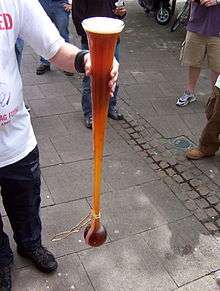
A yard of ale or yard glass is a very tall glass used for drinking around 2.5 imperial pints (1.42 l) of beer, depending upon the diameter. The glass is approximately 1 yard (90 cm) long, shaped with a bulb at the bottom, and a widening shaft which constitutes most of the height.[14]
The glass most likely originated in 17th-century England where the glass was known also as a "Long Glass", a "Cambridge Yard (Glass)" and an "Ell Glass". It is associated by legend with stagecoach drivers, though was mainly used for drinking feats and special toasts.[15][16] (Compare with the Pauwel Kwak glass).
Drinking a yard glass full of beer is a traditional pub game. The fastest drinking of a yard of ale in the Guinness Book of Records is 5 seconds.[17]
Capacity
| Volume | Names |
|---|---|
| 125 ml | Galopin o Bock (France), Benjamin (Belgium), Zurito (Basque), Birrino (Italy) |
| 200 ml | Flûte o Hollandais (Belgium), Fluitje (Netherlands) Galopin (Switzerland), Caña (Spain), Stange (Cologne, but only for Kölsch), Birra Piccola (Italy) |
| 250 ml | Demi o Bock (France), Chope o Pintje (Belgium), Cerveza (Spain), Vaasje (Netherlands) |
| 284/285 ml | Middy, Pot, Handle, Schooner, Ten, Half (Australia), Half (UK, Ireland) – 10 Imp fl oz |
| 300 ml | Seidl/Seitel/Seiterl (Belgium) |
| 330 ml | Gourde/Klepke (Belgium), Canette (Switzerland), Mini (Luxembourg), liten öl (Sweden), liten øl (Norwegian), třetinka (Czech), Tercio/Mediana (Spain) |
| 400 ml | Birra Media (Italy), stor öl (Sweden) |
| 425 ml | Schooner (Australia) – 15 Imp fl oz |
| 473 ml | Pint (United States) – 16 US fl oz |
| 500 ml | Distingué, Baron, Mini-chevalier, Chope, Pinte o Sérieux (France), Demi (Belgium), Seidel or Seidla (German), Chope o Canette (Switzerland), Pinta (Spain), halvliter (Norwegian), půllitr (Czech), Krügel/Krügerl (Austria), Halbe (Southern Germany, Austria) |
| 568/570 ml | Chopine (France), Pint (UK, Ireland, Australia), Pinte (Canada) – 20 Imp fl oz |
| 775/950 ml | Beer stein (English), Humpen (German), Holba (Czech) |
| 1 l | Chevalier, Parfait, Double Pinte (France), Corbeau, Lunette, Litron (Belgium), Maß (Germany), Masse o Litron (Switzerland), Birra grande (Italy), tuplák (Czech) |
| 1140 ml | Jug (Australia) – 40 Imp fl oz |
| 2 l | Stiefel/Liesl (Austria) |
The capacity of the "bottes" goes from 30 ml to 3 l.
Australian measures
Prior to metrification in Australia, one could buy beer in glasses of size 4, 5, 6, 7, 10, 15 and 20 (imperial) fluid ounces. Each sized glass had a different name in each Australian state. These were replaced by glasses of size 115, 140, 170, 200, 285, 425 and 570 ml. Progressively, the differences are decreasing. In the 21st century, most pubs no longer have a glass smaller than 200 ml (7 imp fl oz); typically available are 200ml, 285ml and 425ml, and increasingly many pubs have pints 570 millilitres (20.1 imp fl oz).
A request for a Pot of Gold in Queensland will produce a 285 ml glass of XXXX Gold.
| Names of beer glasses in various Australian cities[n 1][n 2][n 3] | |||||||||
|---|---|---|---|---|---|---|---|---|---|
| Capacity[n 4] | Sydney | Canberra | Darwin | Brisbane | Adelaide | Hobart | Melbourne | Perth | |
| 115 ml (4 fl oz) | – | – | – | – | - | small beer | foursie | shetland | |
| 140 ml (5 fl oz) | pony | – | – | pony | pony | – | horse/pony | pony | |
| 170 ml (6 fl oz) | – | – | – | – | – | six (ounce) | small glass | bobbie/six | |
| 200 ml (7 fl oz) | seven | – | seven | seven (ounce) | butcher | seven (ounce) | glass | glass | |
| 285 ml (10 fl oz) | middy | half pint / middy | handle | pot[n 5] | schooner[n 6] | ten (ounce) | pot | middy/half pint | |
| 350 ml (12 fl oz) | schmiddy[n 7] | – | – | – | – | – | – | – | |
| 425 ml (15 fl oz) | schooner | schooner | schooner | schooner | pint[n 6] | fifteen / schooner | schooner[n 8] | schooner[n 8] | |
| 570 ml (20 fl oz) | pint | pint | pint | pint | imperial pint[n 6] | pint | pint | pint | |
Notes:
|
References: | ||||||||
See also
References
- ↑ Wisconsin's best breweries and ... Google Books. Retrieved 2010-03-01.
- ↑ Duane Swierczynski, The big book o' beer: everything you ever wanted to know about the greatest beverage on earth, page 122. Quirk Books, 2004, ISBN 1931686491. Retrieved 2010-03-01.
- ↑ Garrett Oliver (Sep 9, 2011). The Oxford Companion to Beer. Oxford University Press. p. 304.
- ↑ The Times: Last orders for traditional pint glass as search begins for alternatives
- ↑ The Independent: Collapse of Glass Firms Calls Time on Dimpled Jugs
- ↑ "The return of the dimpled pint glass". BBC News. 30 April 2014. Retrieved 30 April 2014.
- ↑ Ben McFarland, World's Best Beers: One Thousand Craft Brews from Cask to Glass, page 27. Sterling Publishing Company, Inc., 2009, ISBN 1402766947. Retrieved 2010-03-10.
- ↑ The Beer Journal. Google Books. Retrieved 2010-03-10.
- ↑ US dict: stīn
- ↑ Gary Kirsner (1999). "A Brief History of Beer Steins". Archived from the original on 3 June 2009. Retrieved 19 June 2009.
- ↑ "A Brief History of German Beer Boots, and Where You Can Find Them". The Huffington Post. 29 September 2014. Retrieved 2 August 2015.
- ↑ Trip Advisor on La Lunette
- ↑ "Tankard at British History Online".
- ↑ The dictionary of beer and brewing – Google Books. Google Books. Retrieved 2010-03-10.
- ↑ "Yard-of-ale glass (drinking glass) – Britannica Online Encyclopedia". britannica.com. Retrieved 2010-03-10.
- ↑ "The Yard of Ale : Our History". theyardofale.com. Archived from the original on 4 March 2010. Retrieved 2010-03-10.
- ↑ The Guinness book of records 1999. Guinness. 1998. p. 60. Retrieved 28 June 2011.
External links
-
 Media related to Beer glasses at Wikimedia Commons
Media related to Beer glasses at Wikimedia Commons
